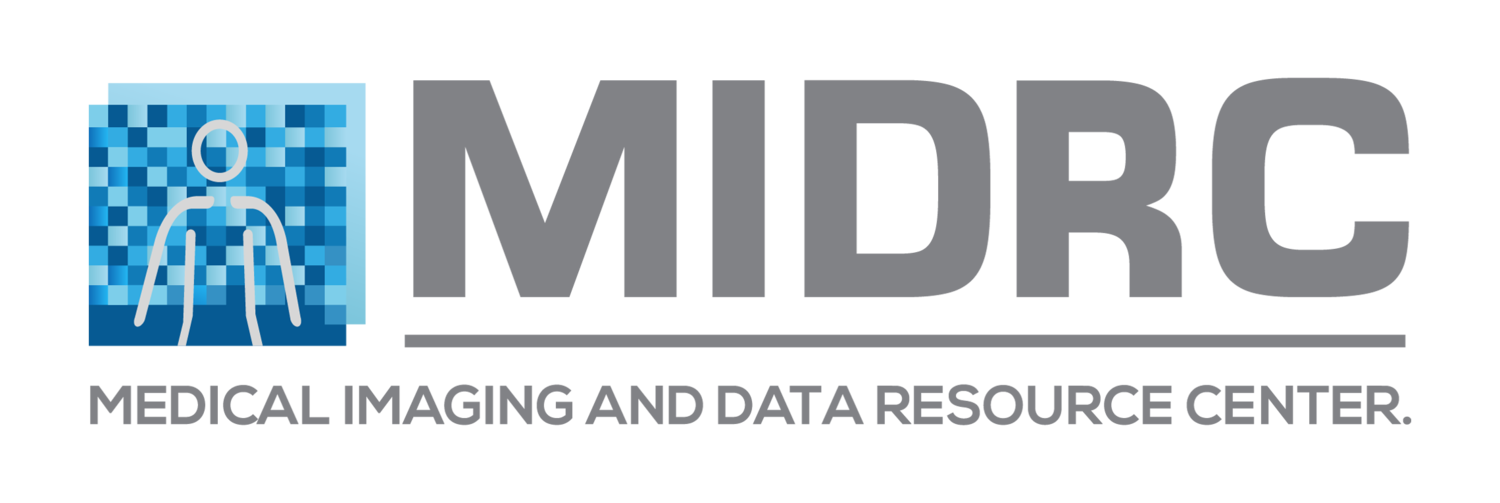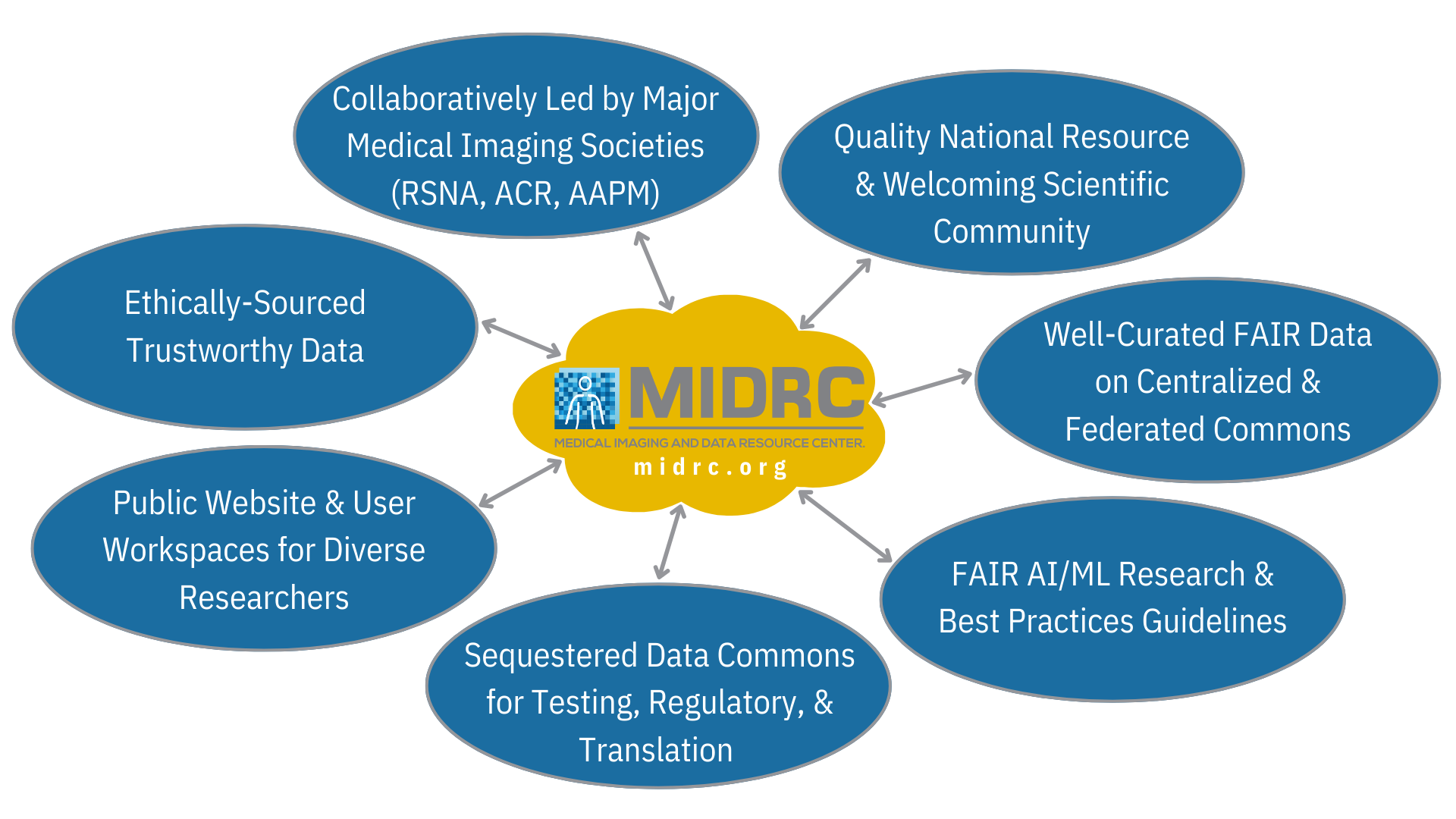More about MIDRC.
MIDRC principles and goals
Last updated February 21, 2024
Currently, MIDRC is expanding to include more image types, more anatomies, and different disease types with a focus on cancer. The infrastructure initially built to collect and curate medical images and meta data for the use-case of COVID-19 is being adapted for this purpose. Also, while the COVID-19 pandemic is no longer deemed a global health emergency, the SARS-CoV-2 virus is here to stay and people are still affected by COVID every day, both in the form of acute COVID-19 and through long term effects of COVID-19 (PASC, Post-acute Sequelae of SARS CoV-2, sometimes referred to as ‘long-COVID’). COVID-19 continues to have significant individual and societal impact, and it is imperative to continue to strengthen our understanding of acute and long COVID. Moreover, lessons learned from this pandemic are invaluable to prepare for, and respond to, any potential future health emergencies as well as chronic diseases.
The first goal of MIDRC continues to be building and expanding its artificial intelligence-ready data commons to fuel machine intelligence research, coupled with standardization, curation, and compliance with ethical responsibilities to honor patients' privacy. In order to leverage existing infrastructure, MIDRC is a high-quality date commons adhering to the FAIR principles (Findable, Accessible, Interoperable and Re-usable). The public access "front door" of MIDRC is hosted by the state-of-the art Gen3 Data Ecosystem housed at the University of Chicago. Through the MIDRC Data Commons Portal, medical images and metadata are disseminated to investigators to expedite medical image analysis research. Please note that MIDRC is actively looking for clinical sites to contribute medical images and associated data, emphasizing the importance of the inclusion of smaller clinical sites such as community hospitals, in order to mitigate potential bias in the data collection. An important focus of the MIDRC data commons is to develop interoperability strategies with other (non-imaging) data commons so that users can link imaging data (including the metadata available in MIDRC) with more extensive electronic health record data available in other repositories.
The second goal of MIDRC is to foster machine intelligence research in the development of algorithms for the detection, diagnosis, monitoring, and prognosis of disease. To this end, five Technology Development Projects (developing infrastructure) and 12 Collaborating Research Projects (performing research and providing recommendations on best practices) are part of MIDRC. Each consists of a team of experts in their field with algorithms being made available on the MIDRC GitHub and providing multiple other resources. MIDRC also hosts scientific challenges benefiting the research community and ultimately clinicians and patient care at large.
The third goal is to help medical imaging investigators meet the new 2023 NIH Data Management and Sharing Policy. This NIH policy is intended to promote research discovery, rigor, and reproducibility through improving the FAIRness (Findable, Accessible, Interoperable, and Re-usable) of data. As a high-quality medical imaging data repository, MIDRC is here to help fulfill this new requirement.
MIDRC’s expanding network.
In January 2024, the U.S. National Science Foundation and collaborating agencies launched the National Artificial Intelligence Research Resource (NAIRR) pilot, a first step towards realizing the vision for a shared research infrastructure that will strengthen and democratize access to critical resources necessary to power responsible AI discovery and innovation. This pilot will enable AI research requiring privacy and security-preserving resources and will assemble exemplar privacy preserving resources. MIDRC has been selected to participate in this pilot project.
MIDRC was selected in September 2023 as one of several performers for the ARPA-H Biomedical Data Fabric (BDF) Toolbox. The ARPA-H BDF is an initiative to de-risk technologies for an easily deployable, multi-modal, multi-scale, connected data ecosystem for biomedical data. MIDRC will provide domain expertise and data commons technology development in medical imaging.
Creation of MIDRC is being accomplished through five main Technology Development Projects that build upon the inter-dependence and synergy across ACR, RSNA, and AAPM. In addition, MIDRC supports 12 synergistic Collaborating Research Projects involving multiple academic institutions across the United States, all operating under principles of open science.
Questions? Check out our answers to frequently asked questions!
How to acknowledge 1) MIDRC funded research and 2) use of data downloaded from the MIDRC Data Commons











